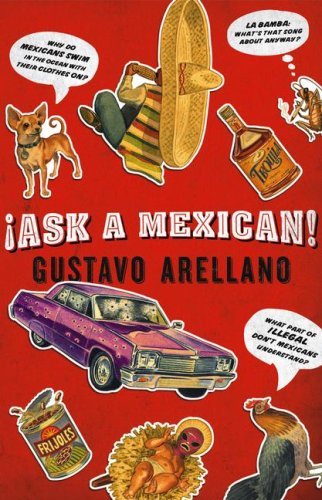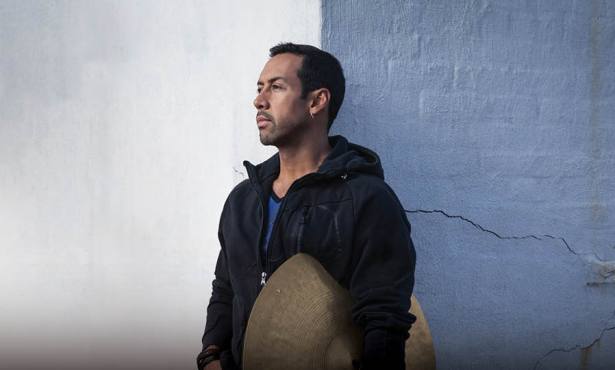“¡Ask a Mexican!” Answers Our Questions
Syndicated Columnist Gustavo Arellano Visits Carpinteria This Weekend

Gustavo Arellano writes the nationally syndicated column “¡Ask A Mexican!” that appears in the OC Weekly, where he is also the food editor and an investigative reporter. Each week, he responds to readers’ questions regarding virtually anything to do with Mexicans.
He has compiled a selection of his responses in a book of the same title, which he will read from this Saturday, January 26, at the Carpinteria Woman’s Club, from 2-4 p.m. It is a fundraiser for The Writing Project, a program of the Carpinteria Valley Arts Council, and costs $5. Call 259-5099 for tickets or see artscarp.org for more info.
Arellano spent some time last week to chat with The Independent‘s Adrian Castaneda. What follows is an edited transcript of that interview.
You also work as a food critic, but do you feel the title of “A Mexican,” where suddenly everyone’s turning to you for answers on everything in Mexican culture from menudo recipes to Dickies pants, has been suddenly forced on you?
It’s not forced on me. If it was forced on me I wouldn’t do it. No reporter wants to do something because people tell them to do it; they want to do it of their own volition. I’m not just a food critic – my first job I was a music critic, then a food critic and that turned into being an investigative reporter and of course now I do the column. That’s what I’m more notorious for, but I still work as a food critic and investigative reporter for the OC Weekly.
People do call me up and ask me, “Oh why do Mexicans do this and that?” and I always tell them, “Look, the column is called Ask A Mexican not Ask THE Mexican“. I might bill myself as the world’s foremost authority on Mexican culture, but that’s just part of the satire of the column.
Really, I’m just one of many voices. If I was the only voice out there I wouldn’t do it.
What’s great about the column is that it isn’t just for gabachos but Mexicans themselves might learn something new about their own culture. Is this something you set out to do from the beginning or was it more about confronting the misconceptions American have of Mexicans?
From the very beginning, the column was done to challenge everybody about every idea they ever had about Mexicans. You know racist folks think Mexicans are a just illegal alien anchor babies that live off taxpayer money for free. That’s not true. And on the left, we think, “Oh all Mexicans are hard working. They’re saints,” and that’s not true either.
Mexicans are just humans and whenever you take an extreme position, that exotifies the people concerned.
So my point is to debunk stereotypes both good and bad. But my focus is to critique the people I call the “know nothings,” the people who think Mexicans are a blight upon the United States and are going to cause it’s downfall.
Of the responses you get to the column, do you get more hate mail from Mexicans that feel insulted or from these “know-nothings”?
I’d say 20 percent of the mail I get is hate mail. That could, of course, mean that all the people that don’t like the column just don’t want to write to me. But of the hate mail I get, I’d say it’s about half and half. It’s a little, but [there are] more racist white folks who say, “Oh you’re just spreading lies.” Which is funny, because Latinos say the same thing: “You’re spreading lies about us. You’re perpetuating stereotypes.” And the Latinos who write those hate letters, usually they’ve only read one column, and I admit you could read one column and you could completely have the column out of context. In fact, people have gotten suspended from their work for reading my column at work because the bosses thought it was a racist and sexist column. Which is absolutely insane, if you ask me.

So I tell people, not just Latinos but all people on the left, “Just do me a favor, read my column for a month, then you can get the bigger scope of what I’m trying to do.” And more often than not, those people who initially didn’t like the column, they end up becoming fans and they say, “Wow, I never knew the column was so varied. Thank you so much for what you’re doing.” I have a lot of conversion stories in a sense.
Are there any aspects of Mexican culture, maybe things that you’ve gotten asked about, that make you cringe or maybe embarrass you a little bit?
Any time it gets to some of the vices that are part of Mexican culture, I don’t like answering them and I always criticize them. For example, homophobia in the Mexican community, I would argue it’s endemic. Of course not all Mexicans are homophobic but there is a very big strain of homophobia.
Also, here in the L.A. area, there’s a lot of tension between black and brown and I would argue that’s something that’s part of the Mexican mindset to be racist against people with darker skin and I criticize that as much as I can in the column. Some of the most racist questions I’ve received have been from Mexicans bashing African-Americans for whatever reason and those folks, I just cuss them out. I get really, really upset.
So I do cringe when I have to confront some of the realities of the Mexican community, but again there’s going to be problems in all communities. Because there’s a problem in a Mexican community, is that reason enough to hate them? No, absolutely not. You should criticize that problem in the community, but you shouldn’t form an all-encompassing opinion on a community based on that one fault.
Speaking of faults, you seem to pick on Chicano Studies majors a lot, almost as much as Guatemalans, so I’m going to assume that wasn’t your major in college. But what role do you see Chicano Studies playing in the representation of Mexican the Mexican community in American society?
I think it’s very telling that UC-Santa Barbara’s Department of Chicano Studies is co-sponsoring my lecture next Saturday. They get the critiques that I have about Chicano studies and I’ve written about it before. I think Chicano Studies is very important. I think people should take a Chicano Studies course to understand the contributions that Chicanos or Mexicans or whatever you want to call us have made to the United States.
I also think, though, that Chicano Studies has its problems in having a particular orthodoxy. As a reporter, I’m taught to be skeptical of everything. To me, nothing is really gospel; nothing is the absolute truth. And in any college discipline they teach you a certain story and I think in Chicano Studies, sometimes there’s not enough reflection or room to accommodate differing thoughts on Chicano Studies. So when I do criticize Chicano Studies and I receive criticism from some people, they just prove my point when they start criticizing my view on it. Of course not all Chicano studies majors or programs criticize me. Sometimes they do understand the satire and what I’m trying to do, but sometimes not as well. :
The column makes fun of everyone, not just Chicano Studies majors. I make fun of fat people, skinny people, men, women, gays and lesbians, straight people. There are no sacred cows.
The only people I would never make fun of in the column, the only real saints out there, are undocumented college students. Kids who are going to college without papers, paying out-of-state tuition, working full-time, and yet the United States government has the gall to say, “You kids aren’t worthy of citizenship and you guys aren’t worthy of paying in-state tuition.” That would be the only group of people I wouldn’t make fun of.
Do you feel the animosity towards Mexicans in Southern California is increasing or decreasing?
There’s always been animosity in Southern California. It’s always been bubbling under the surface. Going back to the days when Americans were first coming into California and calling the Californios a bunch of lazy, shiftless people. That rhetoric that you saw used back in the 1840s is similar to what we hear today, it just changes in approach and format but the animosity is always there. Of course, at the same time, Southern California in particular has a very Mexican culture – in the case of Santa Barbara:Californios, Mission days, and Spanish revival are lionized. That’s just a nice way of saying, “That’s Mexican culture that you’re celebrating.” But you could never call it Mexican culture because, if you celebrate it as Mexican culture, then it’s not “California Culture.”
A lot of the questions you get are from Californians, but there are questions from all over. How is your column received in other places with large Mexican communities like Chicago or San Antonio where people might have a slightly different experience of Mexican culture?
I get questions from all across the country, but probably half are from California, but the rest are from all over. The main reason is because the column is from Orange County. In the early days of the column, which you can see in the book, a lot of my questions are tailored specifically to Orange County and the Southern California lifestyle.
But since the column is now in syndication in 31 newspapers across the country, I’ve had to be cognizant that maybe a reference or a joke that might play well in Los Angeles won’t make sense to somebody in El Paso or New York. One time somebody wrote in a question about gardeners saying, “Mexican gardeners aren’t good. Why can’t they be like the Japanese gardeners of the past?” So I started answering it, but I realized the Japanese gardener was very much a Southern California phenomenon. In New York, people don’t have gardens, so if I answer this question, I’m going to have to answer it in a way that they’ll get or make a comparison to something they will understand.
For the most part, when I answer questions, it’s on statistics, on things that are going to be applicable all across the country. If it’s a particular regional question, then I do answer them and I tell people, “I know this question is specifically geared towards people in Houston but bear with it and learn something about Mexicans in another part of the country and next week I’ll get to your region and your Mexicans.”
So syndication has changed the format of the column?
Only in that way. I mean, the tone of it hasn’t changed, the questions haven’t changed, my philosophy for it hasn’t changed – only in some of the jokes that I might want to make. For instance, when I first started doing the column, all the jokes were about Orange County, about local political figures. Those would always be my fall guys, the guys that I would cuss out or whatever. Nowadays it has to be national figures, it has to be. I can’t make those jokes about local figures because no one, say, in Houston or Dallas cares about the mayor of Santa Ana here in Orange County.
Obviously, immigration has been a big issue in the elections of the last few years and people make a big deal about the Latino vote as far as being a very crucial group for politicians to reach. But as you mention in your column, a lot of Mexicans are actually very conservative. So how do you think Mexicans will influence this election?
It’s interesting, because the number of Mexicans that are out there is a lot larger than the number of Mexicans that are actually going to vote. Because the Latino community in California is very young, part of it doesn’t have papers or isn’t registered to vote and then even of those who are registered might not go out to vote. But that being said, the numbers of Latinos who do vote are increasing every year, and you always hear this cliche about “the sleeping giant” or Latinos “flexing their political muscle” – all that crap.
Definitely the candidates are going to go after the Latino vote. I don’t think Latinos are going to influence the election as much as people think they might, but they are going to play a role in it. More importantly for Latinos, especially in a presidential election, these people are in an office that they’re going to be in for four years. So they’re going to be campaigning for these people because in four years, you’re going to have even more Latino voters. So whoever wins, when they’re up for reelection, they will have all those Latino voters. So in that sense it’s very crucial.
Number-wise, I think it’s a little overrated, but in terms of the potential and in terms of the reality of the future, Latinos are very, very crucial.
How is the reading going to go?
I’m going talk about the column and my story as the child of Mexican immigrants and our family making it here in the United States. But more importantly, wherever I go I like to get questions and give answers. Especially because I’ve spoken in Santa Barbara before. I’ve spoken at UCSB not this past fall, but the fall before that. And a lot of people knew about the column.
But you know, it’s interesting because The Independent doesn’t carry my column, so I can’t expect there to be a crowd that’s familiar with my work. And that excites me because that means I’m going to go into a room with of people who maybe know me or are skeptical of me, but a lot of people are going to go in and say, “What does this guy have to say”? And I would just tell Santa Barbarans: Come in with an open mind and be ready with your questions.
411
Gustavo Arellano will read from ¡Ask A Mexican! on Saturday, January 26, 2-4 p.m., at the Carpinteria Woman’s Club, 1059 Vallecito Road. It is a fundraiser for The Writing Project, a program of the Carpinteria Valley Arts Council, and costs $5. Call 259-5099 for tickets or see artscarp.org for more info.



